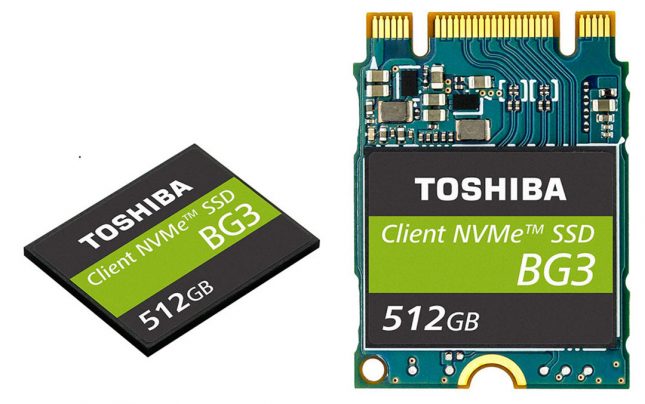Toshiba BG3 SSDs Use 64-layer 3 bit-per-cell TLC BiCS FLASH
Toshiba has rolled out a new SSD series designed specifically for ultra compact mobile computing devices and IoT devices. The small size and large capacity of the new BG3 NVMe SSDs allows these mobile devices and IoT devices to be smaller physically while not sacrificing storage capacity. The new BG3 SSDs are based on Toshiba’s latest 64-layer, 3-bit-per-cell TLC BiCS FLASH and uses single-package ball grid array for connecting to the drives.
That tech allows the SSD to be smaller than the more common SATA-based drives while delivering improved performance. Toshiba also notes that its new BG3 series SSDs also have a smaller footprint than traditional SATA-based drives and use a fraction of the power. That means better battery life and run time for small devices utilizing the storage devices.
BG3 drives use the Host Memory Buffer or (HMB) feature in NVMe Revision 1.2.1 to gain high-performance without using integrated DRAM thanks to its ability to use host memory for flash management purposes. The combination of features used in the BG3 drives allows for performance of NVMe storage with a maximized footprint and affordability.
Despite the small size of the storage solution, they feature PCI Express Gen3 x2 lane and NVMe Revision 1.2.1 architecture and are able to deliver up to 1520 MB/s sequential read speed and up to 840 MB/s sequential write speeds. The BG3 SSDs als offer a SLC cache to accelerate burst type workloads common on Windows PCs. The new BG3 SSDs will be offered in three capacities including 128GB, 256GB, and 512GB and the line is offered in the surface-mount BGA M.2 1620 and removable module M.2 2230 form factors. The series is sampling now to customers and there is no indication when products using the new storage solution might hit the market. The last time we talked about Toshiba storage devices was back in April when the company launched the new N300 HDD series with up to 8TB of storage.

